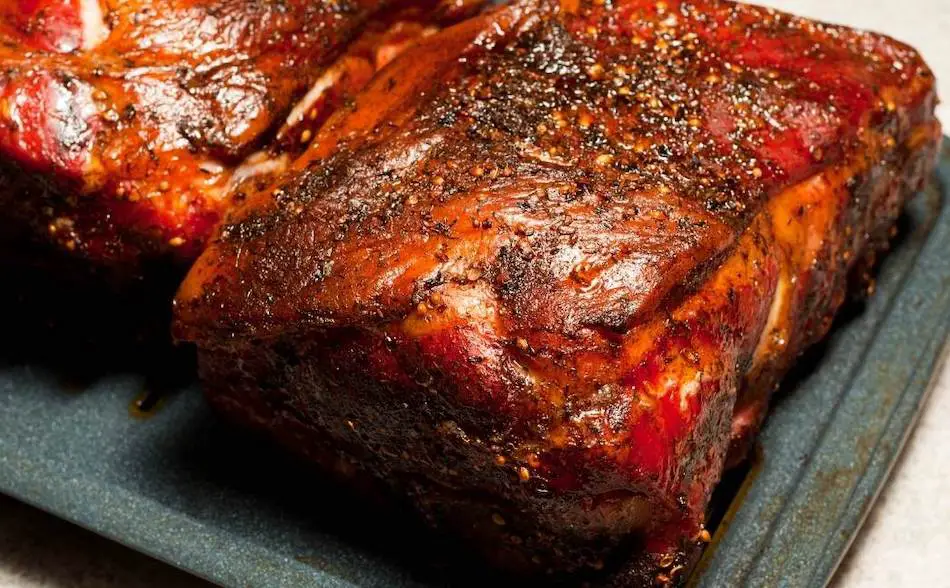
If you’re a fan of low and slow roasting and smoking, you know that it’s all about cooking to the right internal temperature to achieve the best results. Pork butts, also known as Boston butts, are a delicious and flavorful part of the pork shoulder that require a long cooking time at low temperatures to break down the collagen and connective tissue. In this post, we’ll explore the ideal internal temperature for pork butts, as well as the proper cooking techniques to achieve it.
The ideal internal temperature for a perfectly cooked pork butt is between 200°F and 205°F. To achieve this, set the temperature of your smoker between 220°F and 250°F, place the pork on the grill, and leave it for 3 hours without touching it. After 3 hours, you can begin spritzing the pork every 30-40 minutes. Once the internal meat temperature reaches 165°F, wrap the pork in aluminum foil and return it to the heat until the internal temperature reaches 200°F.
The total cook time for a pork butt will depend on the size of the meat and the temperature of the grill, with a general rule of 1.5 hours per pound at 220°F or just over 1 hour per pound at 250°F. After cooking, it is important to allow the pork to rest for at least 1 hour to allow the juices to redistribute. If you are not ready to serve the pork, you can place it in a dry cooler, wrapped in foil, to keep it hot for up to 4 hours or longer.
To ensure accurate temperature readings and the best results, it is recommended to have both a wireless remote thermometer and an instant-read thermometer. Remember to follow proper safety guidelines when handling and cooking pork, including washing your hands and cooking surfaces, and using a meat thermometer to ensure that the pork has reached the recommended internal temperature before serving.
Key Points
- When smoking a pork butt, it is important to cook the meat to a specific internal temperature rather than relying on time alone. The ideal internal temperature for a perfectly cooked pork butt is between 200°F and 205°F.
- To cook a pork butt, you should set the temperature of your smoker between 220°F and 250°F, place the pork on the grill, and leave it for 3 hours without touching it. After 3 hours, you can begin spritzing the pork every 30-40 minutes.
- Once the internal meat temperature reaches 165°F, the pork should be wrapped in aluminum foil and returned to the heat until the internal temperature reaches 200°F.
- The total cook time for a pork butt depends on the size of the meat and the temperature of the grill. As a general rule, a pork butt will take 1.5 hours per pound to cook at 220°F, or just over 1 hour per pound at 250°F.
- After cooking, it is important to allow the pork to rest for at least 1 hour to allow the juices to redistribute. If you are not ready to serve the pork, you can place it in a dry cooler, wrapped in foil, to keep it hot for up to 4 hours or longer.
- Quality thermometers are essential for successful low and slow cooking. It is recommended to have both a wireless remote thermometer and an instant-read thermometer to ensure accurate temperature readings.
- To ensure the best results, it is important to follow proper safety guidelines when handling and cooking pork, including washing your hands and cooking surfaces, and using a meat thermometer to ensure that the pork has reached the recommended internal temperature before serving.
Step By Step – How To Cook A Pork Butt
| Step | Description |
|---|---|
| 1 | Raise the temperature of your smoker between 220°F and 250°F. |
| 2 | Place the pork on the grill and leave for 3 hours without touching. |
| 3 | After 3 hours, begin spritzing the pork butt every 30 to 40 minutes. |
| 4 | Once the internal meat temperature reaches 165°F, wrap the pork in aluminum foil. |
| 5 | Place the pork back in the heat and cook until the internal meat temperature reaches 200°F. |
| 6 | Remove the pork butt and allow it to rest for at least 1 hour. |
Go By Touch and Temperature
Measuring the internal meat temperature shows how close the pork is to being done. However, most pitmasters will tell you to go by feel more than temperature. When you insert a probe into the meat, it should be like butter. Some people will also use a toothpick to assess the meat. It’s best to use both methods by first testing multiple parts of the meat with a thermometer and noting the tenderness.
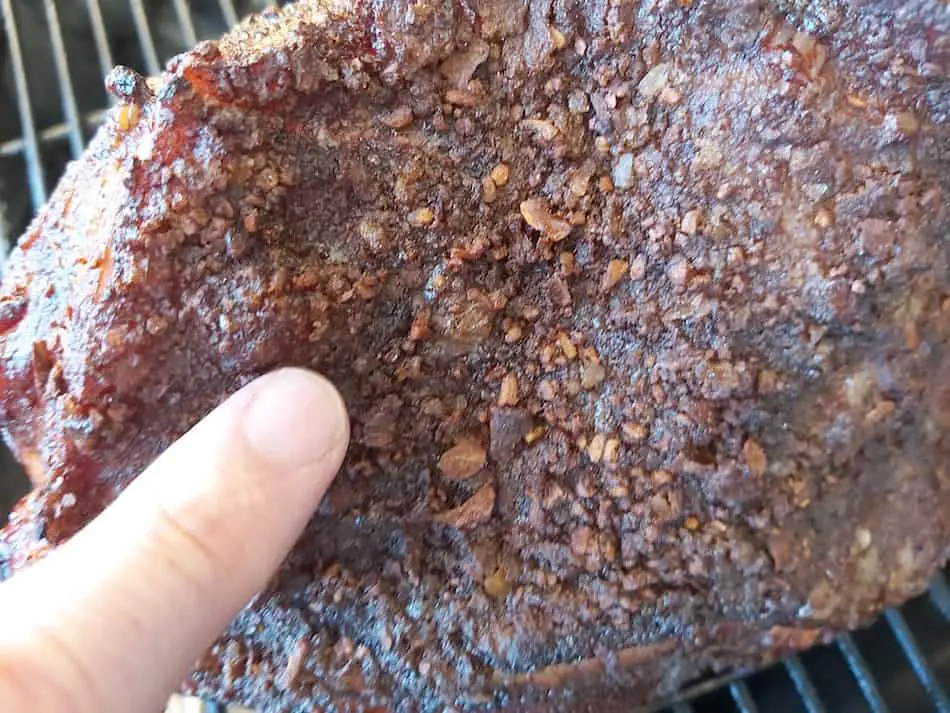
How Long Does It Take To Smoke A Pork Butt?
The total cook time of a pork butt is dependent on the temperature and the size of the meat. A good way to estimate the cook time is 1.5 hours per pound at 220°F. So a 6 pound pork butt would take roughly 9 hours at 220°F. I like to cook pork butts a little hotter at 250°F because it saves time and the pork butt can handle it. If you were to cook at 250°F, allow just over 1 hour per pound. So a 6 pound pork butt at 250°F will take around 6 to 7 hours. For more information, check out this article: How Long Does It Take To Smoke Pork Butt? We Break It Down For You.
Done Temps For Pork Butt
The USDA recommends pork be cooked to a safe internal temperature between 140°F to 160°F, however, eating a pork butt at this temperature is not recommended. Pork butt contains a lot of collagen and connective tissue that requires a lot of time to breakdown. If you were to remove the pork at 140°F, even though it is safe to eat at this temperature, the meat will be chewy because the connective tissue would not have rendered. Taking the pork up to 200°F will ensure the collagen has time to breakdown, making the pork tender and juicy.
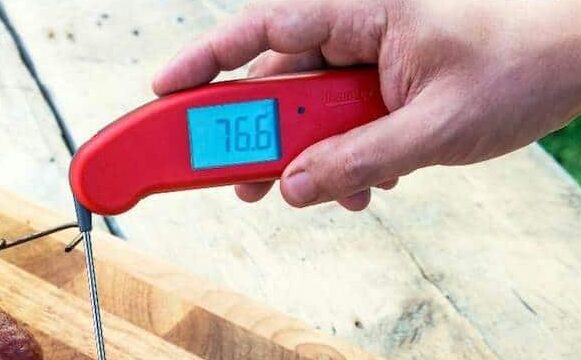
World Brisket Champion Harry Soo is now sharing his secrets with his Competition Meat Rubs.
Resting Pork
Resting the pork butt is an essential step in the cooking process that should not be overlooked. After the pork butt has been cooked to the desired internal temperature and removed from the heat, it is important to allow the meat to rest for a period of time. During this resting period, the juices in the pork will have the opportunity to redistribute, ensuring that the final product is moist and juicy. If you were to slice or shred the pork immediately after removing it from the heat, much of the moisture would be lost, resulting in dry and overcooked meat. It is recommended to allow the pork butt to rest for at least 30 minutes, or even up to an hour, before slicing or shredding.
Check out this article: Rest Pork Butt How Long?
Place The Butt Into Holding
Holding is like resting, but serves a different purpose. If you aren’t ready to serve the meat, keep the butt in the foil wrapping and place the pork in a dry cooler. When large roasts are stored this way, it can stay hot for up to 4 hours or longer. Placing the butt into holding gives you flexibility if you aren’t ready to serve. You might also be interested in this article: Holding Meat In A Cooler-How Long Does It Stay Hot?

Use Good Thermometers
Quality thermometers are the key to successful low and slow cooking because it removes all the guesswork. Cheap thermometers aren’t worth the trouble as many are wildly inaccurate. So too are in-built factory thermometers that come with your smoker or grill. If you want to take meat smoking seriously, buy a duel probe remote thermometer. There are two types of thermometers you should own. The first is a wireless remote thermometer that allows you to monitor the internal temperature of the pork with one probe while also keeping track of the smoker with a second probe. The other must-have tool is an instant-read thermometer for measuring the temperature of multiple parts of the meat within seconds. This is especially useful in the final stages of the cook. Check out our Meat Thermometer Guide.
Wrapping Pork Butt
The best time to wrap pork butt is when the internal meat temperature reaches around 165°F or thereabouts. Also, before wrapping, make sure the pork has a firm outer crust because once the meat is wrapped, the bark will soften. If you have developed a good bark to begin with, then you should still have a decent bark after a few hours in the foil.
A tip I learned from barbeque guru Harry Soo is to sprinkle brown sugar onto the pork, then laying and a few sticks of butter on top before closing the wrap. Another idea is to add some extra moisture to create steam. If you want to understand the differences between wrapping, check out this article: Should I Wrap In Foil or Paper?
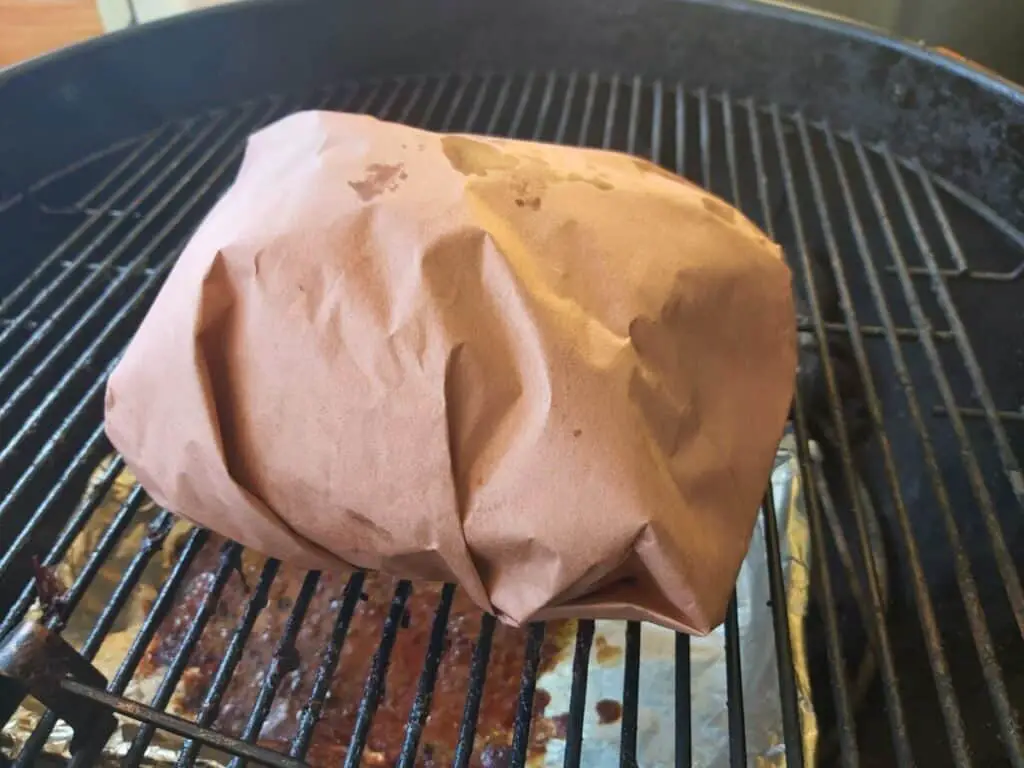
Have you tried smoking a Wagyu brisket yet? You can get one delivered to your door from Snake River Farms.
Can You Finish Pork Butt In The Oven?
If you want to save on charcoal and wood, a good idea is to finish the pork butt in the oven. Once the meat has reached the wrapping stage, it will not take on any more smoke, so it won’t make any difference to the flavor of the meat. To follow this method, smoke the pork butt as you normally would, but once the meat reaches the wrapping stage, shut down your smoker, wrap the pork butt and bring it inside. Leave the thermometer probe inserted so you can continue to track the internal meat temperature. Purists will say this is cheating, but it makes sense. Wood and charcoal are expensive, and the meat is getting no benefit after it’s wrapped. For more on this strategy, check out this article: Finishing Pork Butt In The Oven-Is It Cheating?
Does Spritzing Slow The Cook?
When cooking tough cuts of meat such as pork shoulder, it required time at low temperatures to break down all the connective tissue and render all the fat.
Spritzing the pork butt will slow down the cook because it cools the meat, extending the cook. One problem with spritzing is it can destabilize your smoker. People most commonly spritz hourly, which means every hour your smoker is losing heat when you open the lid. It can also have the opposite effect by giving the fire a massive shot of oxygen, which will spike the temperature.
The best time to spritz a pork butt isn’t until around 3 to 4 hours into the cook. It’s best to leave the pork alone for the first few hours, and just let the butt absorb smoke. This will also allow the smoker to maintain a stable temperature. Learn more about spritzing Pork butt here. How To Spritz Pork Butt
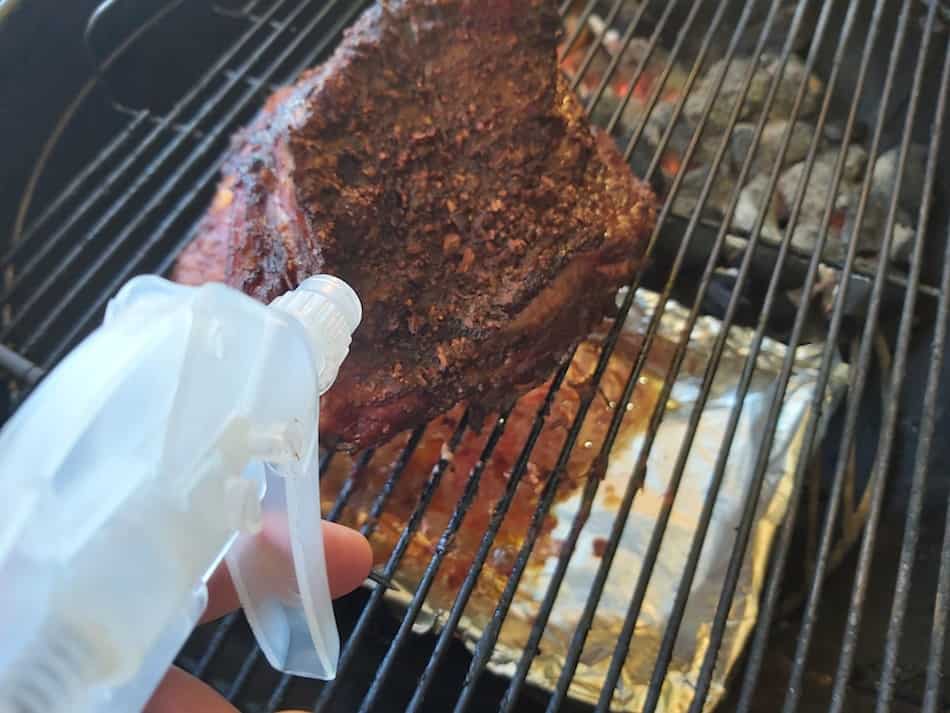
Did you know there’s now a meat thermometer with no wires that can control with your phone? Check out MEATER
Different Sizes Make A Difference
The size of the pork will make a tremendous difference when trying to work out total cook times. Pork butts are usually weigh between 6 to 10 pounds. A huge 10 pounder could take up to 20 hours to cook if done low and slow, whereas a small 6 pound butt could be done in 5 hours if cooked at a higher temperature.
The Stall – How It Slows The Cook Time
The stall is something all pitmasters have to contend with, and it can have a major impact on the cooking time. A pork butt will usually stall at around 150°F and can last for several hours. Foiling the pork and increasing the temperature of your smoker are the best ways to push through the stall. The stall occurs when the meat sweats and the moisture cools the surface of the meat, slowing the cook down significantly. For more on this subject, you might be interested in this article: 7 Ways To Deal With The Stall.
My Favorite Meat Smoking Tools
Thanks for checking out this article. I hope you learned a few things. Here are some of my favorite tools I use when smoking brisket that may be useful to you. These are affiliate links, so if you decide to purchase any of these products, I’ll earn a commission. But in all honesty, these are the tools I recommend to my family and friends who are just starting out.
Meat Thermometer: There are dozens of fancy thermometers on the market, but I still use my trusty TP20. For around $50, I have a high-quality meat thermometer with two probes, and can track the temperature of my smoker with one probe, and my meat with the other probe. The ThermoPro TP20 is an Amazon Best Seller because it’s the easiest thermometer to operate, is durable, highly accurate, and comes with pre-programmed meat settings.
Instant Read Thermometer: Arguably, the second most important tool you need is a fast and accurate instant-read thermometer. These tools play an important role in the latter stages of the cook when the meat needs regular checking in multiple areas. I use the ThermoPro TP19 because it can do everything a ThermaPen can do, but for a fraction of the cost. You can check out the TP19 on Amazon here.
Wireless Thermometer: The latest thermometers on the market have no wires and can be controlled by wi-fi via your phone. Airprobe 3 is the best of this technology.
Butcher Paper: Wrapping brisket in butcher paper has become a huge trend in barbeque thanks to Aaron Franklin. Wrapping your brisket in paper will give you a nice brisket bark. However, you can’t just use any old paper, it has to be unwaxed, food grade paper. You can find it on Amazon here.
Advanced Thermometer and Automatic Temperature Controller: Once you’re ready to take things seriously, the FireBoard 2 Drive is a six-channel Bluetooth/Wi-Fi thermometer that can monitor up to 6 pieces of meat, control and graph your cook sessions on your smartphone, and attaches to an an automatic blower that will convert your charcoal smoker to a set-and-forget. This is one of the most advanced meat thermometers on the market. You can check it out on the FireBoard website here.

